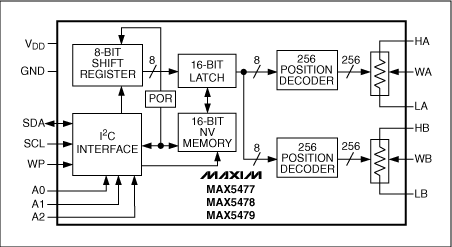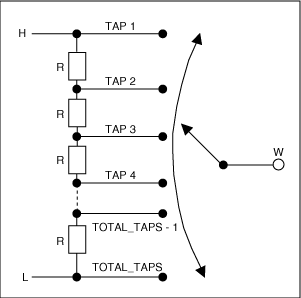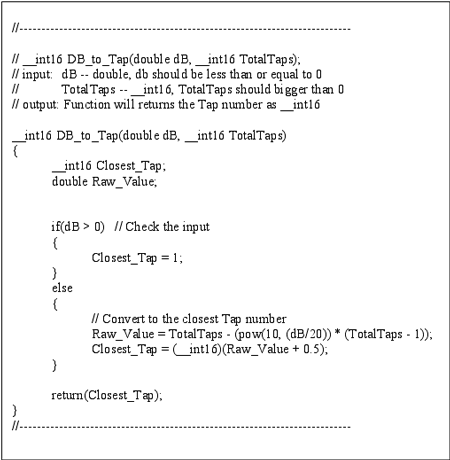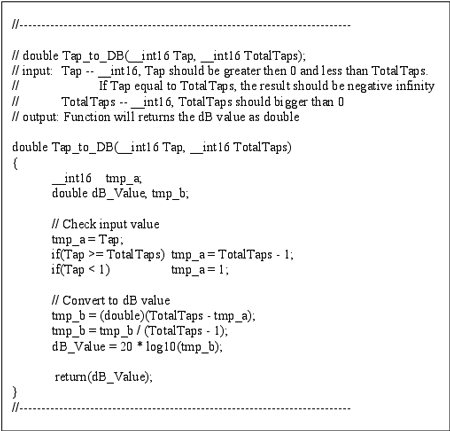Download: GUI software (ZIP, 229kB) Overview Digital potentiometers have the advantages of high reliability, small size, and ease of use. They are widely used to replace mechanical potentiometers, especially in terms of volume control. The application is very common. Considering that the human ear's perception of volume attenuation is non-linear, logarithmic attenuation is regarded as linear attenuation. Therefore, audio equipment generally tends to use logarithmic digital potentiometers rather than linear digital potentiometers. If only high-resolution linear digital potentiometers are provided in the system, the linear potentiometer (Figure 1) can be converted into a logarithmic potentiometer in the following manner without changing the system hardware.

Figure 1. This series of digital potentiometers are equipped with a standard configuration, with high-end, low-end, and center-tap connection points of the resistance string. The position of the center tap can be moved along the resistance string.
Logarithmic adjustment with a linear potentiometer The use of a simple and easy-to-understand linear-tap digital potentiometer with a mathematical relationship can complete the function of a logarithmic digital potentiometer. Since the digital potentiometer is essentially a voltage divider circuit, its output voltage has a certain correspondence with the input voltage VIN (VIN acting on RH) acting on both ends of the potentiometer, which can be expressed by the following formula:
VOUT = VIN (RW-L / RH-L)









 (Formula 1)
(Formula 1) Among them, RW-L is the resistance value between the center tap (W) and the low end (L) of the resistance string, and RH-L is the total resistance between the two ends of the potentiometer.
Calculate the decibel number of voltage attenuation according to the following formula:
Attenuation (dB) = 20 * log (VOUT / VIN)


 (Formula 2)
(Formula 2) Substituting VOUT of equation (1) into equation (2), the following relationship can be obtained:
Attenuation (dB) = 20 * log [VIN (RW-L / RH-L) / VIN] = 20 * log (RW-L / RH-L)


 (Formula 3)
(Formula 3) As shown in Figure 2, the resistance value can be expressed by the position of the tap of the potentiometer (RW-L) and the total number of taps (RH-L).

Figure 2. The tap point of the linear potentiometer is at the position of the bisector string
The position of the potentiometer tap (RW-L) can be expressed as:
RW-L = (Total_Taps-x) * R







 (Formula 4)
(Formula 4) Where x = 1, 2, 3 ... Total_Taps, Total_Taps is the total number of taps.
Since the first tap point (minimum attenuation) contains no resistance, the total end-to-end resistance is: RH-L = (Total_Taps-1) * R, the attenuation can be expressed by the following formula:
Attenuation (dB) = 20 * log [(Total_Taps-x) / (Total_Taps-1)]








 (Formula 5)
(Formula 5) Where x
Conclusion It can be seen from the above analysis that it is completely feasible to convert a linear potentiometer to a logarithmic potentiometer. This method is very suitable for high-resolution linear potentiometers (128 taps or higher), because the resolution of the logarithmic potentiometer is strict Limited to the range of linear tap points (less than 128). In addition, due to internal structures such as the ESD protection circuit or the non-linear on-resistance of the transistor as a switch, accuracy may be affected at the end point. The program code given below can realize the conversion between the attenuation amount and the tap position (Figure 3) and the required tap position and attenuation (Figure 4).

Figure 3. This program is used to convert between attenuation and tap position

Figure 4. This program is used to convert between tap position and attenuation
A similar article was published on EE TImes on April 4, 2005.
We disign and manufacture Linear Actuators For Smart Furniture, modern furniture, like: shelves, bookshelves, shelving, chairs, tables, and desks for the office.
Pls feel free to contact us for more details about this product or other optional product or customize your product!
Linear Electric Actuator is a comfortable and ergonomically correct Actuator, It can provide perfect control and reliable performance to lift, push, tilt or adjust saftly, smoothly and accurately, this Electric Actuator is widely used for various applications, Linear Actuator designed specialized for Smart office furniture , household furniture and medical equipment, such as adjustable work table, electric beauty bed, massage chairs, TV lift, taction beds, dental bed, hospital bed, dental chairs, electric wheel chairs, leisure bed, Smart Recliner chairs, etc...
Electric Linear Actuators for Smart Office, Electric Actuators for Smart Office, Linear Actuators for Smart Office
TOMUU (DONGGUAN) ACTUATOR TECHNOLOGY CO., LTD. , http://www.tomuu.com
